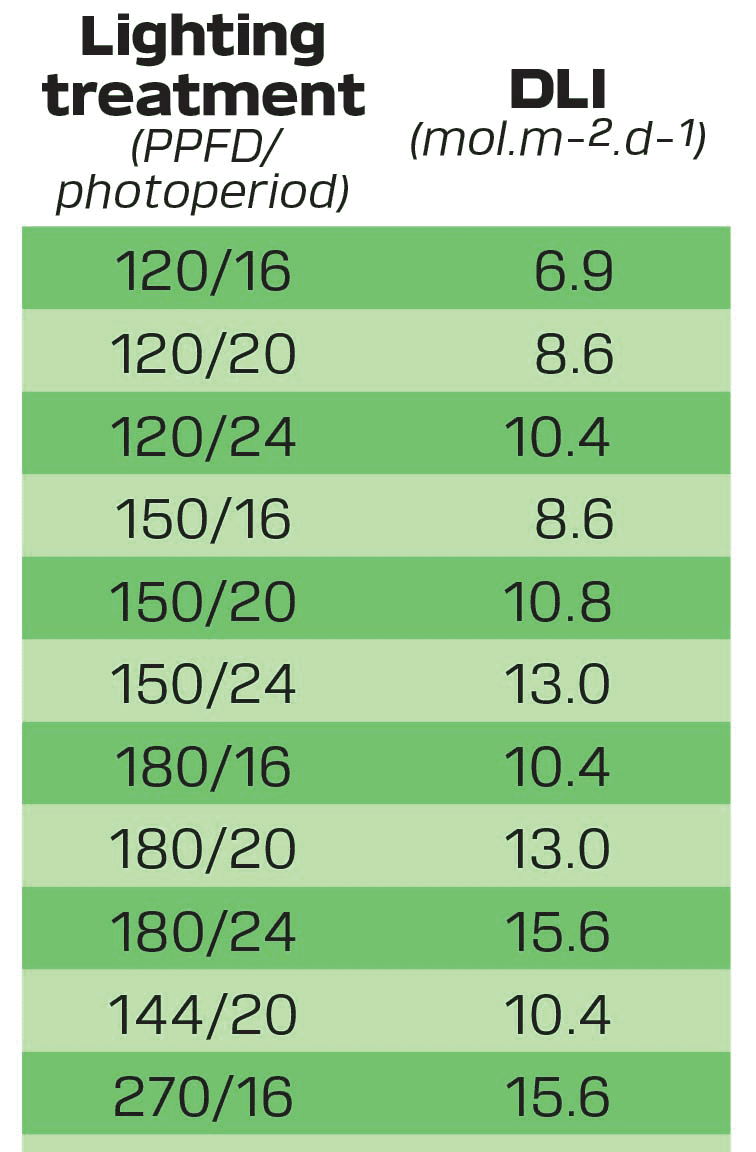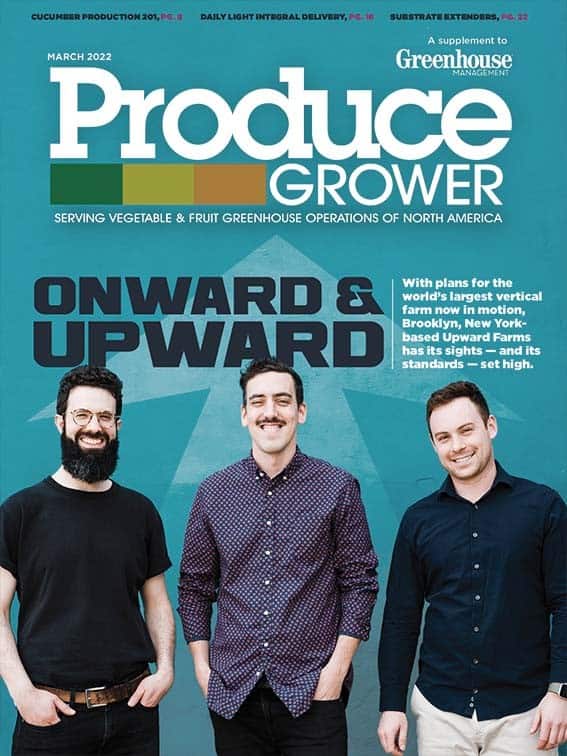The PPFD is the number of photons (400 to 700 nm) that fall in a 1-square-meter area per second. The photoperiod is the duration of light a plant receives in a day. As the product of the PPFD and photoperiod, the daily light integral (DLI) is the cumulative amount of light a plant receives in a day. Increasing the DLI by increasing the PPFD or lengthening the photoperiod typically increases plant growth and yield in most plants. For instance, doubling the DLI from 10 to 20 mol·m–2·d-1 can nearly double lettuce yield, but also increases tipburn occurrence and electrical costs.
Various PPFD × photoperiod combinations can achieve the same target DLI. Do these combinations have the same effect on yield if the DLI is the same? If not, what is the optimal combination for the highest yield per energy input? Here, we investigated the interactions between the PPFD and photoperiod on lettuce growth. Our experiment was designed to answer the question: at the same DLI, will a lower PPFD paired with a longer photoperiod produce lettuce with the same yield as a higher PPFD and shorter photoperiod?

Experimental protocol
In a walk-in growth room, we sowed the seeds of green-leaf lettuce ‘Rex’ and red-leaf lettuce ‘Rouxai’ in rockwool covered with transparent humidity domes under customizable LED fixtures. We grew lettuce seedlings at 72 °F (22 °C) under warm-white (WW) LEDs at a PPFD of 180 µmol·m–2·s-1 before transplanting them into floating rafts of a deep-flow hydroponic system. Recirculated and aerated nutrient solutions (Hydro FeED from JR Peters) was managed to have an average pH of 5.6 and electrical conductivity of 1.7 dS·m-1 with 150-ppm initial nitrogen.
After transplant on day 11, we grew plants under 12 different lighting treatments with the same spectrum from 50% WW + 50% red (peak = 664 nm) LEDs (Fig. 1). The lighting treatments delivered different PPFD × photoperiod combinations to create various DLIs (Table 1). We designed these treatments to 1) determine the effects of increasing the PPFD at a given photoperiod; 2) determine the effects of extending the photoperiod at a given PPFD; and 3) compare different PPFD × photoperiod combinations at the same DLI.
On day 26, we measured the leaf coloration of 10 random lettuce ‘Rouxai’ plants from each treatment. Additionally, on day 27, we harvested 10 random plants of each cultivar per treatment to measure fresh weight, dry weight, plant diameter, leaf length and width, and leaf number. We performed the experiment twice.

Results
Yield
Regardless of the PPFD × photoperiod combination, increasing the DLI from 6.9 to 15.6 mol·m-2·d-1 increased the fresh weight of lettuce ‘Rex’ and ‘Rouxai’ (Fig. 2, Fig. 3). Increasing the photoperiod at a given PPFD increased the yield of both cultivars. For example, at a PPFD of 150 µmol·m-2·s-1, increasing the photoperiod from 16 to 24 hours increased the fresh weight of lettuce ‘Rex’ and ‘Rouxai’ by 53% and 59%, respectively.
Increasing the PPFD at a given photoperiod also increased yield. For example, under a 20-hour photoperiod, increasing the PPFD from 120 to 180 µmol·m-2·s-1 increased the fresh weight of lettuce ‘Rex’ and ‘Rouxai’ by 51% and 38%, respectively. We also measured the dry weight of each lettuce cultivar to determine biomass without potential differences in water content. Fresh and dry weights showed similar trends.
At the same DLI of 15.6 mol·m-2·d-1, different PPFD × photoperiod combinations had different effects on yield. The yield of lettuce ‘Rex’ and ‘Rouxai’ was higher under a lower PPFD × a longer photoperiod than under a higher PPFD × a shorter photoperiod (Fig. 4). However, at the same DLI of 10.4 mol·m-2·d-1, yield was similar regardless of the PPFD × photoperiod combination.

Plant shape
The DLI had a noticeable effect on plant shape, especially for lettuce ‘Rex’. As the DLI increased, plant diameter and leaf length of lettuce ‘Rex’ (but not ‘Rouxai’) decreased, leading to a more compact plant. Additionally, leaf width and leaf number of lettuce ‘Rex’ and ‘Rouxai’ slightly increased as the DLI increased. Lettuce ‘Rouxai’ shape was less responsive to changes in the DLI. We saw no changes in plant diameter or leaf length under the DLIs tested but did see increases in leaf width and leaf number as the DLI increased. Finally, at the same DLI of 10.4 or 15.6 mol·m-2·d-1, the PPFD × photoperiod combination did not affect plant shape of either cultivar.

Leaf color
We measured the leaf color profiles of lettuce ‘Rouxai’ with a colorimeter and included pictures of a representative plant from each treatment for visual reference (Fig. 2, Fig. 3). As the DLI increased, lettuce ‘Rouxai’ leaves appeared redder. In addition, increasing the PPFD at a given photoperiod, or increasing the photoperiod at a given PPFD, increased leaf redness.

Take-home messages
Increasing the DLI, either by increasing the PPFD or photoperiod, increased lettuce yield. Across all treatments, a 1% increase in the DLI resulted in a 0.9% and 0.7% increase in the fresh weight of lettuce ‘Rex’ and ‘Rouxai’, respectively. Increasing the DLI also increased plant compactness and leaf number in both cultivars, and leaf redness in the red-leaf cultivar. Finally, at the highest DLI tested (15.6 mol·m-2·d-1), lettuce yield was higher under a lower PPFD of 180 µmol·m-2·s-1 × a 24-hour photoperiod (continuous light) than under higher PPFDs × shorter photoperiods. Our results align with a similar study performed at the University of Georgia.
Growing plants under a lower PPFD × a longer photoperiod has some potential advantages compared to a higher PPFD × a shorter photoperiod. First, tipburn incidence in some cultivars can possibly be mitigated by lowering the PPFD. Second, the cost of purchasing and installing a lighting system increases with the delivered PPFD, so using a lower PPFD can decrease the initial fixed lighting cost of an indoor farm.

Explore the March 2022 Issue
Check out more from this issue and find your next story to read.
Latest from Produce Grower
- Chilli thrips (Scirtothrips dorsalis)
- GS1 US Celebrates 50-Year Barcode 'Scanniversary' and Heralds Next-Generation Barcode to Support Modern Commerce
- University of Florida offers Greenhouse Training Online program on irrigation water
- Flower trends in full bloom
- Nominate an outstanding leader
- New Florida Extension Agent Will Teach Stakeholders About Food Safety
- Paint it black
- Regular checkups





